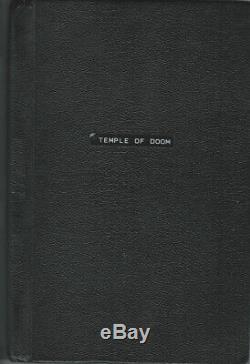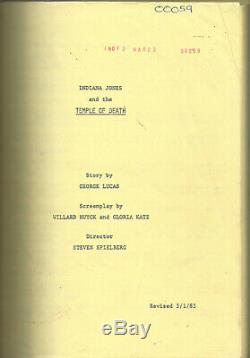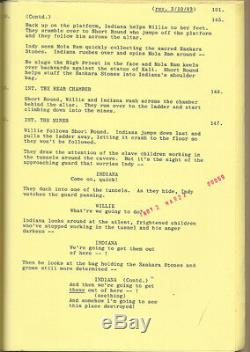
- Homepage
- Author
- Celebrity
- Industry
- Object Type
- Product
- Signed By
- A Star (5)
- Adam Sandler (12)
- Al Pacino (7)
- Charlie Sheen (5)
- Christian Bale (18)
- Dan Aykroyd (8)
- Daniel Radcliffe (10)
- Dustin Hoffman (5)
- Greta Gerwig (5)
- Hans Zimmer (6)
- Jeff Goldblum (5)
- John Travolta (5)
- Kevin Smith (9)
- Martin Scorsese (10)
- Matt Damon (16)
- Quentin Tarantino (10)
- Robert Zemeckis (5)
- Tim Allen (7)
- Wes Anderson (5)
- Whoopi Goldberg (5)
- ... (4728)
INDIANA JONES AND THE TEMPLE OF DOOM (1984) Revised film script, 3/1/83





INDIANA JONES AND THE TEMPLE OF DOOM (1984). Screenplay by Willard Huyck and Gloria Katz. Revised 3/1/83 (under working title INDIANA JONES AND THE TEMPLE OF DEATH). Vintage original script, with red rubber stamp watermark INDY 2 MAR22 00059 on the recto of each leaf.
Mechanically reproduced, raised text, with one revision in original typescript. A working script produced about one month prior to the commencement of shooting, which began on April 18, 1983. From the collection of cinematographer Carlos Gil.
The second film in the renowned Indiana Jones series, a dark prequel to the first installment, Raiders of the Lost Ark. Steven Spielberg spared no effort in making a breathlessly entertaining adventure film in the old style, utilizing a minimum of special effects. Pauline Kael called the film, " one of the most sheerly pleasurable films ever made, " and Roger Ebert deemed it, not so much a sequel as an equal. It's quite an experience. INDIANA JONES AND THE TEMPLE OF DEATH or DOOM however one refers to it is the second film in the Indiana Jones franchise and by far the darkest of the series.
Each of the three films in the initial trilogy appropriated its mythic imagery from one of the world's great religions: RAIDERS OF THE LOST ARK (1981), from Judaism and the Ark of the Covenant; INDIANA JONES AND THE TEMPLE OF DOOM (1984), from Hinduism and the Thugee cult; INDIANA JONES AND THE LAST CRUSADE (1989), from Christianity and the Holy Grail. The fourth film in the series, INDIANA JONES AND THE CRYSTAL SKULL (2008), released roughly two decades after the other three, draws its imagery not from religion, but from the Cold War and 50s sci-fi films, in particular Nigel Kneale's Quatermass series. All four Indiana Jones films are based on stories written or co-written by producer George Lucas. For TEMPLE OF DOOM, Lucas hired screenwriting team Gloria Katz and Willard Huyck, who had previously written Lucas' AMERICAN GRAFITTI, to write the screenplay adapted from Lucas' treatment. TEMPLE OF DOOM is essentially an exercise in pulp Orientalist fantasy, like Robert Siodmak's COBRA WOMAN or Fritz Lang's THE INDIAN TOMB. At the time of its release, TEMPLE OF DOOM was criticized for what many perceived to be offensive East Indian stereotypes. Even before shooting, Lucas and the film's director, Steven Spielberg, were denied permission to shoot in Northern India due to the government finding the screenplay offensive. This is understandable, given that the screenplay's over-the-top East Indian villains are members of a human-sacrificing, child-enslaving Thugee cult who pull hearts out of people's chests while worshipping Kali a goddess who in the actual Hindu religion has both positive and negative aspects. Moreover, the screenplay's "good" East Indians are backward villagers who look to Indiana Jones (Harrison Ford) as their white savior. Additionally, the screenplay's female lead, nightclub singer Willie Scott played in the film by future Mrs.Spielberg, Kate Capshaw is a collection of negative female stereotypes. In contrast to Marion Ravenwood (Karen Allen), the self-reliant Hawksian heroine of the first and fourth Indiana Jones films, TEMPLE OF DOOM's Willie is a vain, gold-digging showgirl, an object of ridicule who complains constantly and screams at the slightest provocation.
It isn't until the story's second half that she begins to show some positive qualities. Notwithstanding the controversy surrounding the film and many critical reviews, TEMPLE OF DOOM went on to become the highest grossing movie of its year -- and remains a beloved classic American movie of the 1980s.First Act Revisions The principle differences between the screenplay and the movie are the "Spielberg-izing" of its first act which, not surprisingly, becomes the most enjoyable part of the completed film. ¶ Both the screenplay and film begin in a Shanghai nightclub where Willie sings a sultry solo.
" In the screenplay, it is called "The Dragon club. In the movie, it is called "Club Obi Wan" (a nod to Lucas' STAR WARS franchise). Willie's song is not described in detail in the screenplay. In the movie, it becomes a rendition of Cole Porter's "Anything Goes, " sung by Willie in Chinese! Except for the "Anything Goes" refrain, and the basis for a Busby Berkeley-style production number elaborately staged by Spielberg and his team.The screenplay immediately introduces Indiana's child sidekick "Short Round" (named after a similar Asian child character in Samuel Fuller's THE STEEL HELMET) sneaking into the club. In the film an improvement we do not meet him until Indy and Willie are escaping from the club.
He is the child driver of their getaway car! The battle in the club between Indy and Chinese gangsters involving a diamond, a poisoned drink, and its antidote is naturally elaborated upon in the film version which introduces a revolving "lazy Susan" on the nightclub table, by means of which the diamond, the antidote, and other valuables are exchanged before everything devolves into chaos. Indy, Willie, and Short Round escape to an airport. In the screenplay, the plane they take is pursued and shot at by two other planes, operated by the Chinese gangsters. In the film again an improvement the plane the good guys take turns out to be owned by the Chinese gangsters, who abandon it without fuel, expecting the good guys to die in a crash landing.
Deleted Sequence In both the screenplay and the movie, Indy, Willie, and Short Round are captured while observing Thugee rituals in the Temple of Death/Doom, and Indy is forced to drink the "blood of Kali" which turns him into a zombie slave. In the screenplay which is even darker than the movie there is an extended sequence, not in the film, where Willie is allowed to return to the Maharajah's palace accompanied by zombie Indy (she does not know he is a zombie). He follows her into her bedroom where "he starts hissing grotesquely, smoke billows out of his mouth, " and his eyes start glowing a hellish incandescent yellow. Aftermath Spielberg must have learned something from the TEMPLE OF DOOM controversy. In an apparent attempt to make amends, the next film he directed was THE COLOR PURPLE (1985), which aspired to a black feminist viewpoint. Title page present, marked copy No. 00059, dated 3/1/83, noted as Revised, with credits for story writer Lucas, screenwriters Huyck and Katz, and director Spielberg. 133 leaves, mechanically reproduced on yellow stock, with yellow revision pages throughout, dated 3/1/83 and 3/10/83. In a custom red quarter-leather clamshell box. Pages NEAR FINE, spring binder NEAR FINE. It must come back in the same condition as it was sent. AUTHENTICATION: My name is Walter Reuben. I have been collecting movie posters since 1978. I have been a full-time dealer since 1982.Everything which I sell is fully researched and entirely guaranteed to be completely authentic and as described. A lifetime of experience goes behind every description of every piece which I offer.
ABOUT ME: For further information, go to the ABOUT ME. The item "INDIANA JONES AND THE TEMPLE OF DOOM (1984) Revised film script, 3/1/83" is in sale since Friday, June 14, 2019.
This item is in the category "Entertainment Memorabilia\Movie Memorabilia\Scripts\Originals\Unsigned". The seller is "walterfilmusa" and is located in Los Angeles, California. This item can be shipped worldwide.- Modified Item: No
- Country/Region of Manufacture: United States
- Format: Script / screenplay

